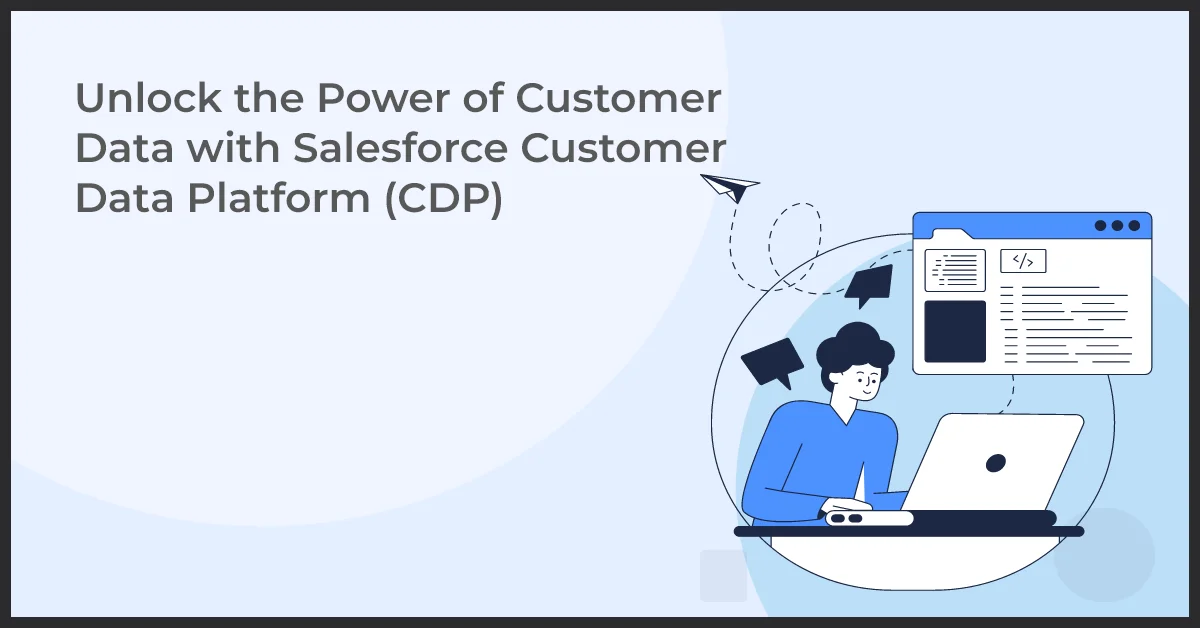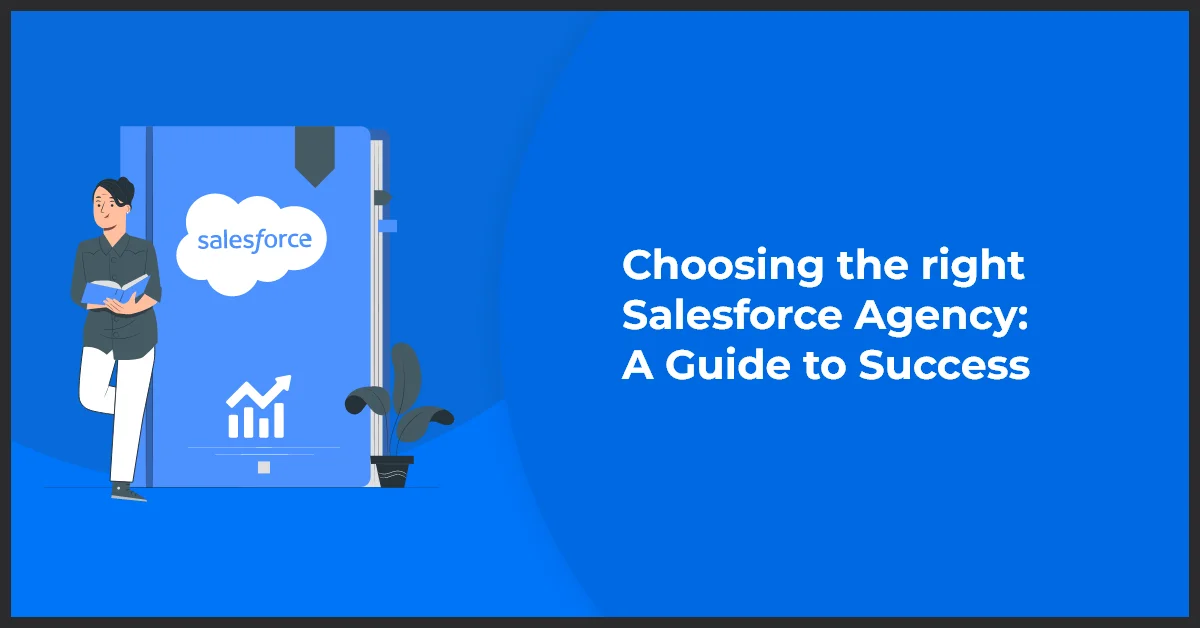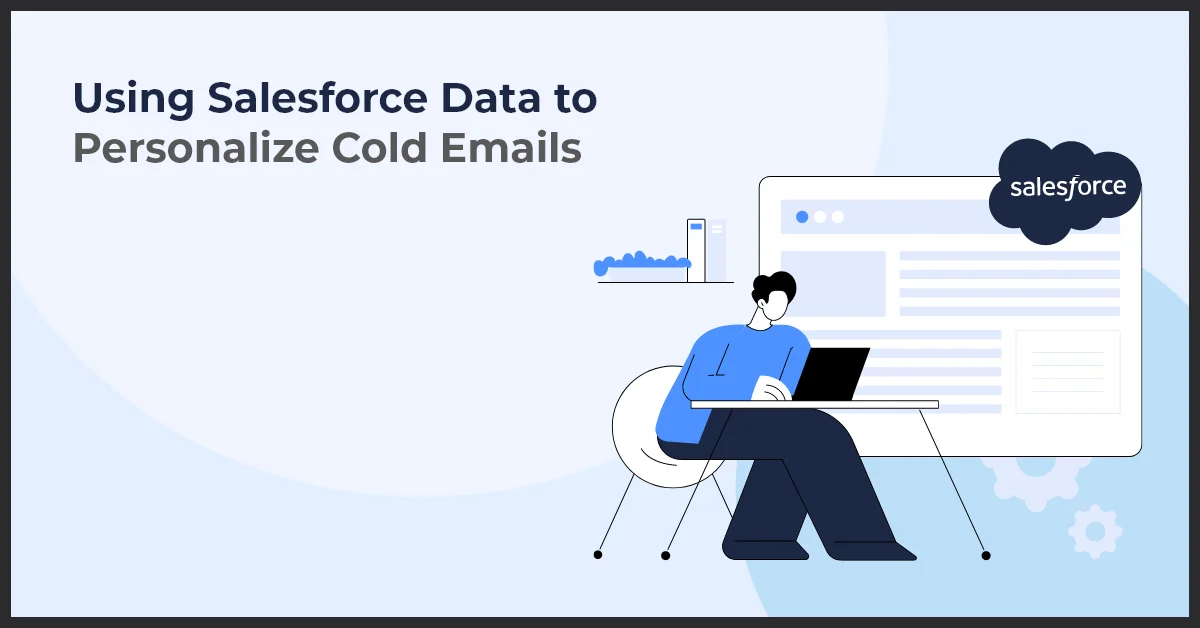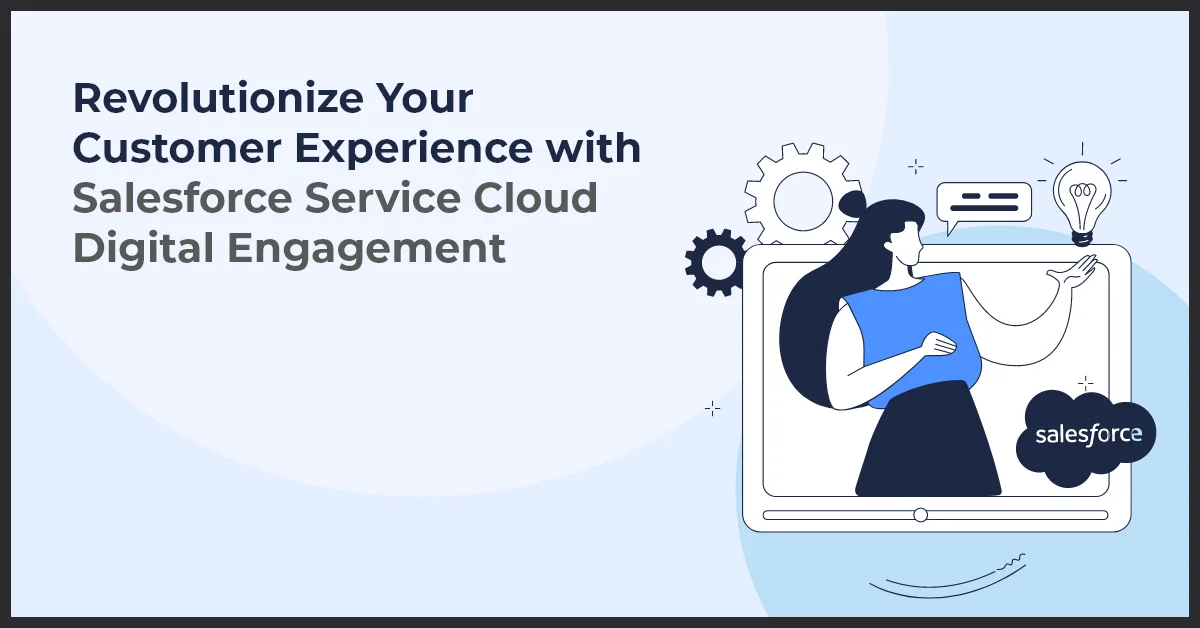Unlock the Power of Customer Data with Salesforce Customer Data Platform (CDP)

Published on: November 16, 2023
Updated on: August 12, 2024
2170 Views
- Salesforce
22 min read
As a business owner or marketer, understanding your customers is crucial for driving successful marketing and sales strategies. Salesforce, a leading CRM platform, offers a powerful solution to help businesses harness the potential of customer data with their Customer Data Platform (CDP).
Customer data plays a vital role in modern marketing and sales efforts. By analyzing customer behaviors, preferences, and interactions, businesses can personalize their marketing campaigns, improve customer experiences, and drive higher conversions. This is where Salesforce CDP comes in.
Salesforce CDP provides businesses with a centralized hub to collect, unify, and activate customer data from various sources, such as websites, mobile apps, customer service interactions, and more. By layering this data with powerful analytics and AI capabilities, businesses can gain deep insights into customer behavior, generate meaningful reports, and make data-driven decisions to optimize marketing and sales strategies.
But what are the actual benefits of using Salesforce CDP? Firstly, it enables businesses to create a comprehensive, 360-degree view of each customer by consolidating data from multiple touchpoints. This holistic view helps businesses understand their customers better, allowing for better segmentation and personalized communication.
In addition, Salesforce CDP enhances marketing and sales efficiency by automating data collection and integration processes. Real-time data synchronization ensures that businesses have the most up-to-date customer information, enabling timely engagements and improved campaign targeting.
Furthermore, Salesforce CDP empowers businesses to deliver personalized experiences at scale. With the ability to analyze large volumes of customer data, businesses can create highly targeted and relevant marketing campaigns, resulting in increased customer satisfaction and loyalty.
Salesforce Customer Data Platform revolutionizes the way businesses leverage customer data to enhance their marketing and sales efforts. By offering a comprehensive view, streamlining data processes, and enabling personalization at scale, Salesforce CDP empowers businesses to stay ahead in today's competitive landscape.
Understanding Customer Data
Customer data refers to the information and details about individuals or organizations that interact with a company's products, services, or brand. It encompasses various forms of data collected through different touchpoints, including demographic information, purchase history, online behavior, preferences, and more.
Types of Customer Data:
- 1. Personal Identifiable Information (PII): This includes data that can be used to identify an individual, such as their name, email address, phone number, social security number, and more.
- 2. Demographic Information: This includes characteristics of individuals, such as age, gender, occupation, income level, and location.
- 3. Behavioral Data: This includes information about customers' actions and interactions with a company, such as website visits, product purchases, email opens, clicks, and more.
- 4. Psychographic Data: This includes data related to customers' attitudes, beliefs, values, lifestyle choices, interests, and preferences.
Importance of Accurate and Comprehensive Customer Data:
Accurate and comprehensive customer data is crucial for businesses as it enables them to:
- Gain a deep understanding of their target audience and customer segments.
- Personalize and tailor marketing messages, campaigns, and offers to specific customer needs and preferences.
- Improve customer service and support by anticipating customer requirements and resolving issues proactively.
- Optimize sales and marketing strategies by identifying high-value customers, predicting their behavior, and maximizing customer lifetime value.
- Enhance customer engagement and loyalty through relevant and timely interactions across various channels.
Role of Customer Data in Improving Sales and Marketing Strategies:
Customer data serves as the foundation for effective sales and marketing strategies. By analyzing and leveraging this data, businesses can:
- Gain insights into customer preferences, behaviors, and motivations, enabling them to create targeted and personalized marketing campaigns.
- Identify cross-selling and upselling opportunities based on customer purchasing patterns and behaviors.
- Segment and target specific customer groups for more precise and effective messaging.
- Measure and track the performance of marketing initiatives, attributing sales and conversions to specific campaigns and channels.
- Improve lead generation and customer acquisition by identifying and targeting high-potential prospects.
By understanding and utilizing customer data effectively, businesses can drive better sales and marketing outcomes, enhance customer satisfaction, and ultimately achieve greater success.
Exploring Salesforce CDP Features
As a leading customer data platform (CDP), Salesforce offers a wide range of powerful features that empower businesses to effectively manage and leverage their customer data. In this section, we will delve into the key functionalities of Salesforce CDP and explore the benefits it brings to data management and integration, as well as how it enables personalized marketing campaigns.
Overview of Salesforce CDP Functionalities
Salesforce CDP provides a comprehensive suite of functionalities designed to streamline and enhance data management processes. With its advanced data ingestion capabilities, businesses can easily merge and consolidate customer data from various sources, such as CRM systems, marketing platforms, loyalty programs, and more. This unified view of customer data allows for a more holistic understanding of customers, enabling businesses to make data-driven decisions and deliver highly personalized experiences.
Moreover, Salesforce CDP offers robust data cleansing and normalization features, ensuring the accuracy and consistency of customer data. It also provides powerful data segmentation tools that allow businesses to group customers based on various attributes, such as demographics, behavior, preferences, and interactions.
Benefits of Using Salesforce CDP for Data Management and Integration
By leveraging Salesforce CDP for data management and integration, businesses can experience a multitude of benefits. Firstly, it simplifies the process of handling vast amounts of customer data, enabling businesses to organize, clean, and unify their data efficiently. The centralized nature of Salesforce CDP eliminates data silos and provides a single source of truth, reducing data redundancy and improving overall data quality.
Additionally, Salesforce CDP facilitates seamless integration with other systems and platforms, allowing businesses to leverage their existing technology stack while unlocking the full potential of their customer data. This integration capability enables businesses to create a unified environment for data-driven decision making and enables cross-functional teams to work collaboratively.
How Salesforce CDP Enables Personalized Marketing Campaigns
Personalized marketing campaigns have become increasingly crucial in today's competitive landscape. With Salesforce CDP, businesses can leverage the power of their customer data to create highly tailored and targeted marketing campaigns. By segmenting customers based on their preferences, behaviors, and past interactions, businesses can deliver personalized messages, recommendations, and offers across multiple channels.
Salesforce CDP also enables businesses to track and analyze customer engagement, allowing them to gain insights into customer preferences and behaviors. These insights can then be used to adjust marketing strategies, optimize campaigns, and deliver highly relevant and timely content to customers.
Salesforce CDP offers a rich set of features that enable businesses to effectively manage their customer data and leverage it for personalized marketing campaigns. By utilizing Salesforce CDP's functionalities, businesses can enhance their data management processes, integrate systems seamlessly, and deliver customized experiences that drive business success.
Data Management and Integration in Salesforce CDP
Data management and integration play a crucial role in ensuring the effectiveness of a Customer Relationship Management (CRM) software like Salesforce Customer Data Platform (CDP).
Overview of data management and integration:
Data management involves the collection, organization, and storage of customer data in a structured manner. It includes processes such as data cleansing, deduplication, and enrichment. Integration, on the other hand, refers to the seamless flow of data between different systems and channels.
Importance of data management in CRM software:
Effective data management is essential for CRM software as it enables businesses to gain a holistic view of their customers. By consolidating all customer data, companies can enhance their decision-making processes, improve customer experience, and drive personalized marketing initiatives.
How Salesforce CDP ensures seamless data integration across channels:
Salesforce CDP simplifies the process of data integration by providing a unified platform that connects various data sources such as customer interactions, sales data, and marketing campaigns. It enables the integration of data from multiple channels, including websites, mobile apps, emails, social media, and more.
The platform offers robust tools and features to facilitate data integration, such as APIs, connectors, and data import wizards. These capabilities allow businesses to effortlessly bring together data from various sources, ensuring a comprehensive and accurate view of customer information.
Furthermore, Salesforce CDP offers real-time data synchronization, ensuring that customer data is always up-to-date across different systems and channels. This eliminates data silos and enables enterprises to deliver consistent experiences to customers at every touchpoint.
Data management and integration are essential components of Salesforce CDP. By effectively managing and integrating customer data, businesses can unlock valuable insights, drive personalized marketing initiatives, and ultimately achieve business success.
Marketing Automation with Salesforce CDP
Marketing automation is a powerful tool that allows businesses to streamline their marketing efforts and enhance customer engagement. With the Salesforce Customer Data Platform (CDP), this process becomes even more efficient and effective.
Understanding marketing automation and its benefits
Marketing automation refers to the use of software and technology to automate repetitive marketing tasks and workflows. It allows businesses to send targeted messages, nurture leads, track customer behavior, and measure campaign effectiveness.
There are several benefits to implementing marketing automation:
- Improved efficiency: Marketing automation helps businesses save time by automating tedious tasks, enabling teams to focus on more strategic initiatives.
- Personalized customer experiences: By analyzing customer data, marketing automation enables businesses to deliver personalized and relevant content to their target audience, increasing engagement and conversions.
- Lead nurturing and conversion: With marketing automation, businesses can nurture leads throughout the buyer's journey, providing them with the right information at the right time, and increasing the likelihood of conversion.
- Measurable results: Marketing automation provides actionable insights and analytics, allowing businesses to track and evaluate the success of their marketing campaigns, and make data-driven decisions.
How Salesforce CDP automates marketing tasks
Salesforce CDP offers a comprehensive suite of features that streamline marketing tasks and enhance automation capabilities. With Salesforce CDP, businesses can:
- Centralize customer data: Salesforce CDP consolidates customer data from various sources, including online and offline channels. This single view of the customer allows businesses to gain a deeper understanding of their audience and deliver personalized experiences.
- Automate email marketing: Salesforce CDP integrates seamlessly with Salesforce Marketing Cloud, enabling businesses to automate email campaigns based on customer behavior, preferences, and segmentation.
- Implement personalized journeys: Using Salesforce CDP's Journey Builder, businesses can create customized customer journeys that automate the delivery of relevant content at each stage of the customer lifecycle.
- Trigger events and actions: Salesforce CDP's automation capabilities allow businesses to automatically trigger events and actions based on specific conditions or customer behavior. This ensures timely and targeted outreach.
Examples of successful marketing automation using Salesforce CDP
Several businesses have leveraged Salesforce CDP to achieve remarkable marketing automation success:
- A global e-commerce company used Salesforce CDP to automate personalized email campaigns based on customer behavior, resulting in a 30% increase in email open rates and a significant boost in revenue.
- A financial services organization implemented marketing automation with Salesforce CDP to nurture leads and provide relevant content at each stage of the customer journey. This resulted in a 25% increase in lead-to-customer conversion rates.
- A software company utilized Salesforce CDP to segment their customer base and automate targeted cross-sell and upsell campaigns. This led to a 20% increase in customer retention and a 35% increase in average order value.
These examples demonstrate the power of marketing automation with Salesforce CDP in driving business growth and increasing revenue.
Customer Analytics and Segmentation with Salesforce CDP
Understanding consumer behavior is vital for businesses to optimize their marketing strategies and personalize customer experiences. Customer analytics plays a crucial role in analyzing customer data to gain insights into their preferences, needs, and behaviors.
With Salesforce Customer Data Platform (CDP), businesses can efficiently perform customer analytics and segmentation to unlock valuable information about their target audience.
Role of customer analytics in understanding consumer behavior
Customer analytics involves using data to understand customer behavior patterns, preferences, and trends. By analyzing customer data, businesses can gain a deeper understanding of their target audience and make informed decisions to improve their marketing campaigns and enhance customer experiences.
For example, customer analytics can reveal patterns in purchasing behavior, allowing businesses to identify upsell or cross-sell opportunities. It can also help identify customer segments with common characteristics, enabling targeted marketing efforts.
How Salesforce CDP facilitates customer segmentation
Salesforce CDP offers robust features that simplify the process of customer segmentation. It allows businesses to create dynamic customer segments based on various criteria, such as demographics, purchase history, engagement levels, and more.
By segmenting customers, businesses can tailor their marketing messages and campaigns to specific groups, maximizing the relevance and impact of their communication. Salesforce CDP's intuitive interface makes it easy to create, modify, and manage customer segments, ensuring that businesses can adapt their strategies as customer preferences evolve.
Data Privacy and Security in Salesforce CDP
In today's digital landscape, data privacy and security are of utmost importance for businesses. Customers entrust their valuable information to companies, expecting it to be handled in a secure manner. Salesforce Customer Data Platform (CDP) understands the significance of safeguarding customer data and has implemented various measures to ensure data privacy and security.
Importance of data privacy and security in CRM software
An effective Customer Relationship Management (CRM) software like Salesforce CDP relies heavily on customer data. The data collected includes personal information, purchase history, and online behavior. Protecting this data is crucial for maintaining customer trust and complying with privacy laws.
By prioritizing data privacy and security, businesses can avoid costly data breaches, reputational damage, and legal consequences. Customers are more likely to engage with companies they trust, knowing that their data is handled responsibly and securely.
Measures taken by Salesforce CDP to ensure data privacy and security
Salesforce CDP is committed to providing a secure platform for managing customer data. Here are some key measures implemented to protect data privacy and security:
- Data Encryption: Salesforce CDP uses industry-standard encryption protocols to secure data transmission and storage. This ensures that sensitive information remains confidential and protected from unauthorized access.
- Identity and Access Management: Salesforce CDP offers robust identity and access management features to control user access and permissions. This ensures that only authorized individuals can view, modify, or delete customer data.
- Auditing and Monitoring: Salesforce CDP tracks and records all data activities, allowing businesses to monitor and identify any unusual or unauthorized access attempts. This proactive approach helps prevent data breaches and ensures compliance with data protection regulations.
- Data Backup and Recovery: Salesforce CDP provides regular data backups and disaster recovery options to safeguard against data loss due to unforeseen circumstances. This ensures that businesses can recover and restore customer data in the event of a system failure or data breach.
Compliance with data protection regulations such as GDPR
Salesforce CDP is designed with data protection regulations in mind, including the General Data Protection Regulation (GDPR). GDPR is a comprehensive privacy law that governs the processing and handling of personal data of European Union (EU) residents. Salesforce CDP enables businesses to comply with GDPR requirements by providing features such as data subject access requests, consents management, and data deletion capabilities.
By using Salesforce CDP, businesses can align their data practices with GDPR guidelines, ensuring transparency, accountability, and customer rights when it comes to their personal information.
Single Customer View with Salesforce CDP
Achieving a single customer view is crucial for businesses looking to enhance their customer experience and drive personalized marketing campaigns. It involves consolidating all customer data from various sources and channels into a unified profile.
With Salesforce Customer Data Platform (CDP), businesses can effortlessly create a holistic view of their customers. By integrating data from multiple touchpoints such as marketing platforms, sales systems, and customer service interactions, Salesforce CDP offers a comprehensive understanding of each customer.
The benefits of having a single customer view are immense. Firstly, it allows businesses to gain a 360-degree view of their customers' preferences, behaviors, and interactions. This deep understanding enables personalized interactions, tailored recommendations, and targeted marketing campaigns.
Moreover, a single customer view eliminates data silos and inconsistencies that often exist within organizations. By unifying customer data, businesses can streamline their operations and ensure accurate and up-to-date information is accessible to all teams.
Additionally, Salesforce CDP enables businesses to optimize customer engagements across multiple channels. By leveraging a single customer view, companies can deliver consistent messaging and experiences across email, social media, mobile apps, and other touchpoints.
Salesforce CDP empowers businesses to create a single customer view, leading to enhanced customer experiences, improved marketing efforts, and streamlined operations. With a unified understanding of customers, organizations can unlock new opportunities for growth and success.
Omni-Channel Marketing with Salesforce CDP
Omni-channel marketing is a strategy that aims to provide a seamless and integrated customer experience across multiple channels. It allows businesses to connect with customers wherever they are, using various touchpoints such as social media, email, websites, mobile apps, and more.
By embracing omni-channel marketing, businesses can deliver consistent messaging, personalized offers, and a cohesive brand experience to their customers. This approach not only enhances customer satisfaction but also increases engagement and boosts revenue.
With Salesforce CDP, achieving omni-channel marketing excellence becomes easier than ever. The platform centralizes customer data from various sources and creates a unified profile for each individual. This profile includes information such as browsing history, purchase behavior, demographics, and preferences.
Using this comprehensive customer view, businesses can tailor marketing campaigns across multiple channels based on individual preferences and behaviors. Salesforce CDP enables the automation and orchestration of personalized messages, ensuring the right content reaches the right person at the right time.
Real-time customer insights provided by Salesforce CDP empower businesses to make data-driven decisions and optimize their marketing strategies. By analyzing customer behavior across different channels, businesses can refine their targeting, identify gaps, and deliver a consistent and relevant experience throughout the customer journey.
Successful brands have already leveraged Salesforce CDP for omni-channel marketing with remarkable results. For instance, a leading fashion retailer used Salesforce CDP to synchronize data from their online store, mobile app, and physical locations. By understanding their customers' preferences and purchase history, they sent personalized recommendations and offers via email, social media ads, and in-store displays. As a result, they saw a significant increase in customer engagement, loyalty, and revenue.
Data Governance and Enrichment in Salesforce CDP
Accurate and reliable customer data is essential for any business. Without proper data governance, organizations can face numerous challenges in maintaining clean and consistent data. That's where Salesforce Customer Data Platform (CDP) comes into play, offering robust solutions for data governance and enrichment.
Importance of Data Governance for Accurate and Reliable Customer Data
Data governance ensures that data is managed, stored, and accessed in a controlled and secure manner. It sets guidelines and procedures for data management, ensuring the accuracy, consistency, and integrity of customer data. With effective data governance, businesses can make informed decisions, improve customer experiences, and achieve desired outcomes.
How Salesforce CDP Ensures Data Governance and Integrity
Salesforce CDP provides a comprehensive set of tools and features to ensure data governance and integrity. It enables organizations to define data access rules, establish data quality standards, and enforce data protection policies. With Salesforce CDP, businesses can implement data lineage, data validation, and data stewardship processes to maintain high-quality data throughout its lifecycle.
- Data Access Rules: Salesforce CDP allows businesses to define role-based access controls, ensuring that only authorized personnel can access and modify customer data.
- Data Quality Standards: Salesforce CDP provides data profiling and cleansing capabilities, allowing organizations to identify and rectify data inconsistencies, duplicates, and inaccuracies.
- Data Protection Policies: Salesforce CDP helps organizations comply with data privacy regulations by offering features like data masking, encryption, and consent management.
- Data Lineage: Salesforce CDP enables businesses to track the origin, transformations, and movement of customer data, ensuring transparency and accountability.
- Data Validation: With Salesforce CDP, organizations can implement automated data validation processes to ensure that data meets predefined quality standards.
- Data Stewardship: Salesforce CDP allows businesses to assign data stewardship roles, empowering them to manage and resolve data quality issues timely and efficiently.
Role of Data Enrichment in Improving Customer Insights
Data enrichment is the process of enhancing customer data by adding additional information, such as demographic details, behavioral data, and firmographic data. Salesforce CDP facilitates data enrichment by integrating with external data sources and leveraging artificial intelligence (AI) capabilities.
By enriching customer data, businesses gain a deeper understanding of their customers, enabling them to personalize marketing campaigns, segment audiences more effectively, and deliver personalized experiences across various touchpoints.
Furthermore, data enrichment helps in identifying and targeting high-value customer segments, improving lead scoring accuracy, and generating valuable insights to drive business growth.
Real-time Customer Insights with Salesforce CDP
Real-time customer insights have become a game-changer for businesses in today's competitive landscape. The ability to gain immediate access to customer data and analyze it in real-time allows companies to make data-driven decisions, personalize marketing efforts, and ultimately, drive business growth.
With Salesforce CDP, businesses can harness the power of real-time customer insights to stay ahead of their competition. This innovative platform enables companies to not only collect and unify customer data from disparate sources but also analyze and leverage it in real-time.
By using Salesforce CDP, businesses can gain valuable insights into customer behavior, preferences, and interactions across various touchpoints. This deep understanding of customers empowers companies to deliver personalized experiences, offer relevant recommendations, and anticipate customer needs, all in real-time.
But don't just take our word for it. Let's explore some case studies that demonstrate the significant impact of real-time customer insights achieved with Salesforce CDP.
Customer Journey Mapping with Salesforce CDP
Understanding the customer journey is crucial for businesses to deliver exceptional customer experiences. By mapping out each touchpoint and interaction a customer has with a brand, companies can identify pain points, optimize processes, and tailor their marketing strategies accordingly. Salesforce Customer Data Platform (CDP) plays a pivotal role in facilitating customer journey mapping, enabling businesses to gain valuable insights and create personalized experiences throughout the customer lifecycle.
Importance of customer journey mapping in understanding customer experiences
Customer journey mapping allows businesses to visualize the entire customer experience, step by step, from initial awareness to post-purchase support. This comprehensive understanding of the customer journey helps identify gaps, bottlenecks, and opportunities for improvement. By uncovering customer pain points and preferences at each touchpoint, businesses can make informed decisions to enhance customer satisfaction and loyalty. Moreover, customer journey mapping enables organizations to align their internal processes and teams to deliver a seamless and consistent experience.
How Salesforce CDP facilitates customer journey mapping
With its robust data management and integration capabilities, Salesforce CDP serves as a centralized hub for customer data. It aggregates data from various sources, including online interactions, purchase history, customer service touchpoints, and more. This unified view of customer data allows businesses to easily map out the customer journey, analyze customer behavior across channels, and identify key moments of engagement or friction.
Furthermore, Salesforce CDP provides powerful analytics and segmentation features, enabling businesses to create customer segments based on behaviors, preferences, and demographics. These segments can then be used to design personalized customer journeys that cater to the unique needs and desires of each segment.
Examples of successful customer journey mapping using Salesforce CDP
Many businesses have leveraged Salesforce CDP to create exceptional customer journeys that drive engagement and conversions. One example is a global e-commerce retailer that used Salesforce CDP to map out the customer journey from website browsing to final purchase. By analyzing customer interactions at each stage, they identified areas where customers faced difficulties or distractions. With this insight, they optimized their website navigation, simplified the checkout process, and implemented personalized product recommendations. As a result, they saw a significant increase in conversion rates and customer satisfaction.
Another example is a telecommunications company that utilized Salesforce CDP to map out the customer journey for their mobile app. They identified a drop-off point during the onboarding process, where users were abandoning the app. By analyzing user data and conducting surveys, they discovered that the app lacked intuitive features and tutorials. With these insights, they redesigned the onboarding experience, added contextual tooltips, and provided step-by-step guides. This led to a decrease in churn rate and an increase in app engagement.
These examples highlight how Salesforce CDP empowers businesses to map out the customer journey, analyze data, and optimize touchpoints to create tailored experiences that drive customer satisfaction and business growth.
Customer Experience Management with Salesforce CDP
In today's competitive business landscape, delivering exceptional customer experiences has become a top priority for organizations. Customer experience management (CEM) refers to the practice of designing and improving interactions between businesses and their customers to create positive, memorable experiences. CEM focuses on understanding customer needs and expectations, and aligning business processes to meet and exceed those expectations consistently.
Implementing a robust CEM strategy is essential for businesses looking to differentiate themselves and build long-term customer loyalty. This is where Salesforce Customer Data Platform (CDP) plays a pivotal role.
Enhancing Customer Experience with Salesforce CDP
Salesforce CDP offers a comprehensive set of tools and capabilities designed to enhance customer experience management. By unifying and analyzing customer data from multiple sources, organizations can gain valuable insights into their customers' preferences, behaviors, and interactions. This allows businesses to personalize interactions, tailor marketing campaigns, and deliver relevant content to each customer segment.
With Salesforce CDP, organizations can track and measure customer interactions across various touchpoints, such as websites, mobile apps, social media, and offline channels. This enables businesses to create a seamless omnichannel experience, where customers can engage with the brand consistently, regardless of the channel they choose.
Conclusion
Now that we have explored the various aspects of Salesforce Customer Data Platform (CDP), it is evident that this powerful tool can significantly contribute to the success of your business in the world of sales and marketing.
By leveraging Salesforce CDP, businesses can gain a holistic view of their customers, enabling them to make informed decisions and execute effective sales and marketing strategies. The platform's features such as data management, marketing automation, customer analytics, and omni-channel marketing provide businesses with the tools they need to thrive in a competitive market.
To stay ahead and create personalized experiences for customers, it is essential for businesses to explore and implement Salesforce CDP. By doing so, they can unlock the true potential of their customer data and deliver exceptional results.
Don't miss out on the opportunity to transform your business. Get started with Salesforce CDP today and witness the positive impact it can have on your sales and marketing efforts.



